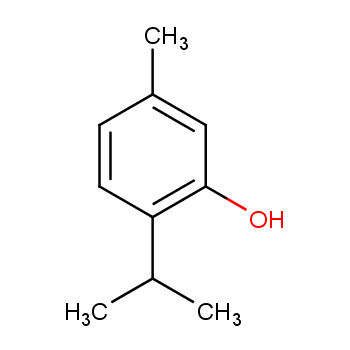 |
 |
1-hydroxy-2-isopropyl-5-methylbenzene 1-methyl-4-isopropyl-3-hydroxybenzene 2-Hydroxy-1-isopropyl-4-methylbenzene 2-isopropyl-5-methyl-pheno 2-isopropyl-5-methylphenol 2-Isopropyl-5-methyl-phenol 2-Isopropyl-5-methylphenol (thymol) 2-Isopropyl-5-methylphenyl sulfate 3-Hydroxy-1-methyl-4-isopropylbenzene 3-hydroxy-4-isopropyl-1-methylbenzene 3-hydroxy-p-cymen 3-methyl-6-(2-propyl)-phenol 3-Methyl-6-isopropylphenol 3-methyl-6-isopropyl-phenol 3-p-Cymenol 5-methyl-2-(1-methylethyl)phenol 5-methyl-2-(propan-2-yl)phenol 5-methyl-2-(propan-2-yl)phenyl sulfate 5-Methyl-2-isopropylphenol 5-methyl-2-propan-2-ylphenol 6-Isopropyl-3-methylphenol 6-Isopropyl-m-cresol EINECS 201-944-8 Isopropyl cresol MFCD00005869 Phenol, 5-methyl-2-(1-methylethyl)- Phenol, 5-methyl-2-(1-methylethyl)-, hydrogen sulfate, ion(1-) Thyme camphor Thymic acid thymol sulfate thymol sulfate(1-)
Reported in EPA TSCA Inventory. EPA Genetic Toxicology Program.
Safety Information of Thymol (CAS No.89-83-8):
Hazard Codes:? C,
C, N
N
Risk Statements: 22-34-51/53?
R22:Harmful if swallowed.?
R34:Causes burns.?
R51/53:Toxic to aquatic organisms, may cause long-term adverse effects in the aquatic environment.
Safety Statements: 26-28-36/37/39-45-61-28?
S26: In case of contact with eyes, rinse immediately with plenty of water and seek medical advice.?
S28:After contact with skin, wash immediately with plenty of soap-suds.?
S36/37/39:Wear suitable protective clothing, gloves and eye/face protection.?
S45:In case of accident or if you feel unwell, seek medical advice immediately (show the label whenever possible.)?
S61:Avoid release to the environment. Refer to special instructions / safety data sheets.?
S28:After contact with skin, wash immediately with plenty of soap-suds.
RIDADR: UN 3261 8/PG 3
WGK Germany: 2
RTECS: XP2275000
HazardClass: 8
PackingGroup: III
HS Code: 29071900
Hazardous Substances Data: 89-83-8(Hazardous Substances Data)
? ?Thymol (CAS No.89-83-8), it also can be called 2-Isopropyl-5-methyl phenol ; 5-Methyl-2-(1-methylethyl)phenol ; 1-Hydroxy-5-methyl-2-isopropylbenzene ; 1-Methyl-3-hydroxy-4-isopropylbenzene ; 2-Hydroxy-1-isopropyl-4-methylbenzene ; 3-Hydroxy-1-methyl-4-isopropylbenzene ; 3-Hydroxy-p-cymene ; 3-Methyl-6-isopropylphenol ; 3-p-cymenol . It is white crystals or powder with a pungent odour. It is the active antiseptic ingredient in the toothpaste Euthymol.
| Organism | Test Type | Route | Reported Dose (Normalized Dose) | Effect | Source |
|---|---|---|---|---|---|
| cat | LDLo | oral | 250mg/kg (250mg/kg) | ? | "Handbook of Toxicology," 4 vols., Philadelphia, W.B. Saunders Co., 1956-59Vol. 5, Pg. 172, 1959. |
| dog | LDLo | intravenous | 150mg/kg (150mg/kg) | LUNGS, THORAX, OR RESPIRATION: DYSPNEA | Therapie. Vol. 3, Pg. 109, 1948. |
| frog | LDLo | subcutaneous | 150mg/kg (150mg/kg) | ? | "Handbook of Toxicology," 4 vols., Philadelphia, W.B. Saunders Co., 1956-59Vol. 5, Pg. 172, 1959. |
| guinea pig | LD50 | oral | 880mg/kg (880mg/kg) | BEHAVIORAL: TREMOR GASTROINTESTINAL: GASTRITIS BEHAVIORAL: COMA |
Food and Cosmetics Toxicology. Vol. 2, Pg. 327, 1964. |
| guinea pig | LDLo | intraperitoneal | 300mg/kg (300mg/kg) | ? | "Handbook of Toxicology," 4 vols., Philadelphia, W.B. Saunders Co., 1956-59Vol. 5, Pg. 172, 1959. |
| guinea pig | LDLo | subcutaneous | 1100mg/kg (1100mg/kg) | ? | "Handbook of Toxicology," 4 vols., Philadelphia, W.B. Saunders Co., 1956-59Vol. 5, Pg. 172, 1959. |
| mouse | LD50 | intraperitoneal | 110mg/kg (110mg/kg) | BEHAVIORAL: SOMNOLENCE (GENERAL DEPRESSED ACTIVITY) BEHAVIORAL: ATAXIA |
Quarterly Journal of Crude Drug Research. Vol. 19, Pg. 1, 1981. |
| mouse | LD50 | intravenous | 100mg/kg (100mg/kg) | BEHAVIORAL: SLEEP | Journal of Medicinal Chemistry. Vol. 23, Pg. 1350, 1980. |
| mouse | LD50 | oral | 640mg/kg (640mg/kg) | PERIPHERAL NERVE AND SENSATION: SPASTIC PARALYSIS WITH OR WITHOUT SENSORY CHANGE LUNGS, THORAX, OR RESPIRATION: RESPIRATORY STIMULATION |
Osaka Shiritsu Daigaku Igaku Zasshi. Journal of the Osaka City Medical Center. Vol. 5, Pg. 111, 1956. |
| mouse | LD50 | subcutaneous | 243mg/kg (243mg/kg) | BEHAVIORAL: SOMNOLENCE (GENERAL DEPRESSED ACTIVITY) SKIN AND APPENDAGES (SKIN): HAIR: OTHER |
Osaka Shiritsu Daigaku Igaku Zasshi. Journal of the Osaka City Medical Center. Vol. 5, Pg. 111, 1956. |
| rabbit | LDLo | intravenous | 60mg/kg (60mg/kg) | ? | "Handbook of Toxicology," 4 vols., Philadelphia, W.B. Saunders Co., 1956-59Vol. 5, Pg. 172, 1959. |
| rabbit | LDLo | oral | 750mg/kg (750mg/kg) | ? | Journal of Pharmacology and Experimental Therapeutics. Vol. 17, Pg. 261, 1921. |
| rat | LD50 | oral | 980mg/kg (980mg/kg) | BEHAVIORAL: SOMNOLENCE (GENERAL DEPRESSED ACTIVITY) BEHAVIORAL: ATAXIA BEHAVIORAL: COMA |
Food and Cosmetics Toxicology. Vol. 2, Pg. 327, 1964. |
| rat | LDLo | subcutaneous | 1600mg/kg (1600mg/kg) | ? | "Handbook of Toxicology," 4 vols., Philadelphia, W.B. Saunders Co., 1956-59Vol. 5, Pg. 172, 1959. |
Acute toxicity - Oral, Category 4
Skin corrosion, Category 1B
Hazardous to the aquatic environment, long-term (Chronic) - Category Chronic 2
| Pictogram(s) |    |
|---|---|
| Signal word | Danger |
| Hazard statement(s) | H302 Harmful if swallowed H314 Causes severe skin burns and eye damage H411 Toxic to aquatic life with long lasting effects |
| Precautionary statement(s) | |
| Prevention | P264 Wash ... thoroughly after handling. P270 Do not eat, drink or smoke when using this product. P260 Do not breathe dust/fume/gas/mist/vapours/spray. P280 Wear protective gloves/protective clothing/eye protection/face protection. P273 Avoid release to the environment. |
| Response | P301+P312 IF SWALLOWED: Call a POISON CENTER/doctor/\u2026if you feel unwell. P330 Rinse mouth. P301+P330+P331 IF SWALLOWED: Rinse mouth. Do NOT induce vomiting. P303+P361+P353 IF ON SKIN (or hair): Take off immediately all contaminated clothing. Rinse skin with water [or shower]. P363 Wash contaminated clothing before reuse. P304+P340 IF INHALED: Remove person to fresh air and keep comfortable for breathing. P310 Immediately call a POISON CENTER/doctor/\u2026 P321 Specific treatment (see ... on this label). P305+P351+P338 IF IN EYES: Rinse cautiously with water for several minutes. Remove contact lenses, if present and easy to do. Continue rinsing. P391 Collect spillage. |
| Storage | P405 Store locked up. |
| Disposal | P501 Dispose of contents/container to ... |
none
 |
Literatures:
Ramanathan, Ahalya; Jimenez, Leslie S. Synthesis, 2010 , # 2 art. no. M04609SS, p. 217 - 220  Yield: ~82% |
 |
 |